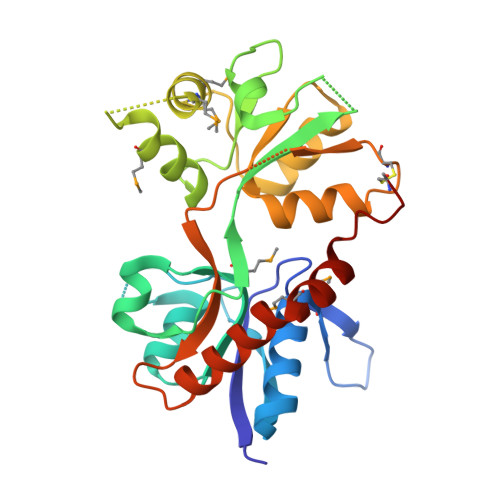Ionotropic Glutamate-Like Receptor {Delta}2 Binds D-Serine and Glycine.
Naur, P., Hansen, K.B., Kristensen, A.S., Dravid, S.M., Pickering, D.S., Olsen, L., Vestergaard, B., Egebjerg, J., Gajhede, M., Traynelis, S.F., Kastrup, J.S.(2007) Proc Natl Acad Sci U S A 104: 14116
- PubMed: 17715062
- DOI: https://doi.org/10.1073/pnas.0703718104
- Primary Citation of Related Structures:
2V3T, 2V3U - PubMed Abstract:
The orphan glutamate-like receptor GluRdelta2 is predominantly expressed in Purkinje cells of the central nervous system. The classification of GluRdelta2 to the ionotropic glutamate receptor family is based on sequence similarities, because GluRdelta2 does not form functional homomeric glutamate-gated ion channels in transfected cells. Studies in GluRdelta2(-/-) knockout mice as well as in mice with naturally occurring mutations in the GluRdelta2 gene have demonstrated an essential role of GluRdelta2 in cerebellar long-term depression, motor learning, motor coordination, and synaptogenesis. However, the lack of a known agonist has hampered investigations on the function of GluRdelta2. In this study, the ligand-binding core of GluRdelta2 (GluRdelta2-S1S2) was found to bind neutral amino acids such as D-serine and glycine, as demonstrated by isothermal titration calorimetry. Direct evidence for binding of D-serine and structural rearrangements in the binding cleft of GluRdelta2-S1S2 is provided by x-ray structures of GluRdelta2-S1S2 in its apo form and in complex with D-serine. Functionally, D-serine and glycine were shown to inactivate spontaneous ion-channel conductance in GluRdelta2 containing the lurcher mutation (EC(50) values, 182 and 507 microM, respectively). These data demonstrate that the GluRdelta2 ligand-binding core is capable of binding ligands and that cleft closure of the ligand-binding core can induce conformational changes that alter ion permeation.
- Biostructural Research Unit, Department of Medicinal Chemistry, University of Copenhagen, Universitetsparken 2, DK-2100 Copenhagen, Denmark.
Organizational Affiliation:


















